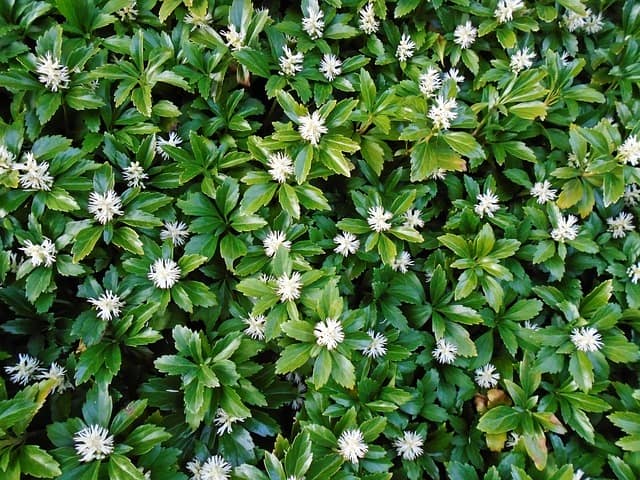Too much sunlight causes yellowing in Pachysandra. The same signs are seen when the plant is in waterlogged conditions. Yellowing is also seen due to Iron Chlorosis, which occurs due to a deficiency of iron in the soil. Foliage may become yellow because of the Spider mite or Root-knot nematode infection.
Pachysandra is an evergreen plant that works great as a ground cover under trees. Pachysandra can survive in partial shade.
Pachysandra can survive in poor soil conditions, even in soils with low pH. It will fit perfectly in your garden if you love green.
| Reason for Yellowing | Prevention/Treatment |
|---|---|
| Too Much Sunlight | Move Pachysandra to partial shade if it's exposed to excessive sunlight. |
| Waterlogged Conditions | Provide proper drainage by creating a ditch or replanting in well-draining soil if needed. |
| Iron Deficiency (Iron Chlorosis) | Test soil pH; if it's too alkaline, add coffee grounds or Iron sulfate according to instructions. |
| Spider Mite Infection | For severe infestations, use diluted insecticidal soap on the affected plants. |
| Root-Knot Nematodes Infestation | Add compost, especially leaf mold, to attract beneficial fungi that combat nematodes in the soil. Use liquid fish emulsion to repel and eliminate nematodes from the soil. |
External conditions
Stress from external conditions is one of the possible reasons why your Pachysandra is yellowing. External conditions like sunlight, water, and nutrients like Iron affect the growth of this ground cover greatly.
Let’s look at how each one of these factors influences it and how to keep them ideal.
Sunlight
Too much sunlight bleaches out the color from the Pachysandra leaves. Foliage becomes light green to yellow in color.
To fix: The only way to fix this issue is by moving your Pachysandra into the partial shade. Cotoneaster is a good ground cover plant that thrives in full sunlight conditions too.
If your plants are already growing in shade, then some other factor is causing this issue.
Water
Check the plant’s roots and the soil for any issues that arise due to waterlogged conditions. Such conditions are seen when the soil is bad at draining excess water.
It causes root rot. If a plant’s roots sit in soggy soil for too long the plant will eventually die.
To fix: Provide a ditch to drain excess water away. If the problem is severe, consider replanting the plant in soil with better drainage.
Iron Deficiency
Iron deficiency also causes yellowing of the leaves. If the rest of the leaf is yellow except the veins, then it is due to a lack of Iron.
Plants can’t absorb Iron in the soil thus developing a condition called Iron Chlorosis.
To fix: If the pH meter indicates that the soil needs to be more acidic, add used coffee grounds or Iron sulfate to the soil according to the instructions.
Spider Mite Infection
Spider mites are common pests that infest many gardens. Look closer and see if you can identify the infestation. Their presence can be confirmed if you see webbing between the leaves.
They are very tiny pests and they feed on the plant sap. They leave white speck-like damage on the leaves as they devour the chlorophyll out of them.
These pests release toxins into the leaves’ veins. These toxins distort and discolor the leaves.
The affected plant’s leaves become stippled, yellow, and dry. Sometimes you will directly see webbings if the infection is severe.
To fix:
- Spray water at the affected plant with a garden hose, to dislodge them. Do this 2 times a week and see if the issue resolves.
- If the infestation is severe, spray diluted insecticidal soap at the affected plant.
Root-Knot Nematodes
Root-Knot Nematodes may infest the Pachysandra plant. These nematodes are just 1/50 to 1/10 inch long, thus invisible to the naked eye.
These pests reside and thrive in the roots of Pachysandra. Plants if infected by these nematodes look wilted and stunted.
Foliage becomes yellow or bronzed and falls off. Inspect the roots to confirm their infestation. The infected roots become decayed and show galls or knots.
To fix:
- Add a lot of compost(especially leaf mold) to the soil where the Pachysandra grows. Doing this attracts beneficial fungi that attack nematodes.
- Add liquid fish emulsion to the soil to repel and eradicate these pesky nematodes.
That’s all! Happy Gardening 🙂

